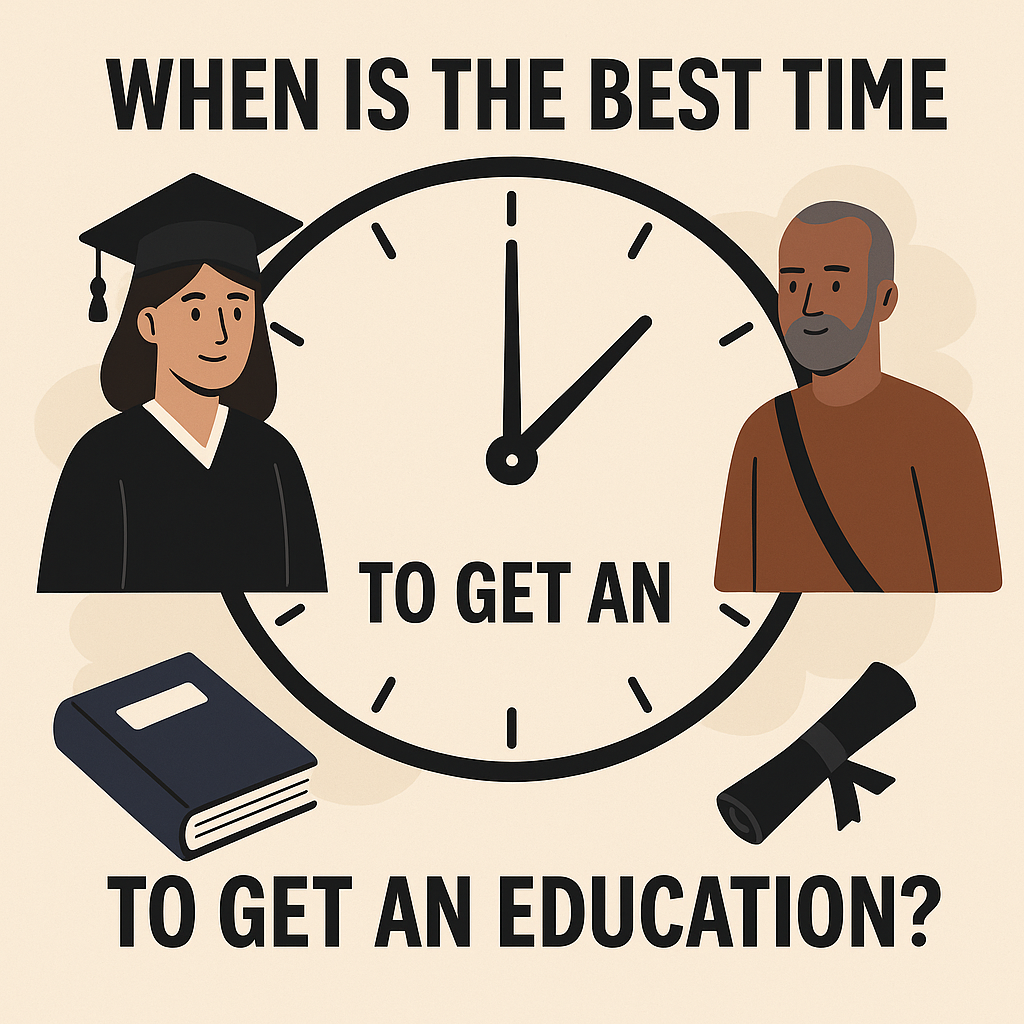Education is a lifelong journey, not just something you pursue in your youth. The question “When is the best time to get an education?” doesn’t have a simple answer. It depends on your personal goals, life stage, financial situation, and even your health. In this guide, we’ll explore different scenarios to help you find the right time to start or resume your educational journey.

Why Timing Matters in Education
The best time to pursue education varies from person to person. Some thrive in traditional college settings during their early 20s, while others find academic success later in life after gaining real-world experience. What’s important is identifying what works best for you—your goals, your responsibilities, and your future aspirations.
1. Personal Circumstances: Your Life, Your Pace
Education at Any Age
There’s no expiration date on learning. Whether you’re fresh out of high school or a working parent in your 40s, education remains accessible. More adults are returning to college than ever before, thanks to flexible learning options and the rise of online programs.
Early Education Advantages
-
Career Head Start: Beginning early often means graduating earlier and entering the workforce sooner.
-
Time to Explore: Younger students can afford to try different courses and majors before settling on a career.
-
Fewer Commitments: Without major family or financial responsibilities, younger students often have more time to devote to their schoolwork.
Later Education Benefits
-
Life Experience: Older students bring real-world context to their studies, often making learning more relevant and practical.
-
Stronger Motivation: Adult learners often have clear goals and a stronger commitment.
-
Career Shifts: Education can open doors for a career change or advancement.
Related Video: Is It Too Late to Go Back to School?
2. Managing Family Responsibilities While Studying
Education while raising a family can feel like a balancing act, but it’s possible. With planning, support, and a flexible learning approach, many parents successfully earn degrees.
Supportive Resources for Parents in School
-
Flexible Class Schedules – Platforms like Coursera and edX offer online courses that fit any schedule.
-
Childcare Options – Find federally supported childcare resources via ChildCare.gov.
-
Peer Support Groups – Facebook groups such as Student Moms & Dads offer peer-based encouragement.
Real-Life Examples
-
Single Parents Earning Degrees: Many single mothers and fathers have graduated while raising children, proving that dedication and planning can lead to success.
-
Dual Role Professionals: Working parents who pursue education part-time often find their career prospects improve dramatically upon graduation.
3. Health, Disability, and Education: Overcoming the Hurdles
Chronic health conditions or disabilities don’t have to be barriers to education. With the right accommodations and support systems, students of all abilities can thrive academically.
Tools That Empower
-
Assistive Technology – From speech-to-text to screen readers, assistive tech levels the playing field.
-
Reasonable Accommodations – Section 504 ensures equal access in higher education.
-
Counseling and Tutoring – Organizations like NAMI offer mental health resources for students.
Inspirational Stories
-
People like Stephen Hawking, despite physical limitations, made groundbreaking contributions through education. These stories remind us that determination often outweighs obstacles.
4. Career Goals: Let Your Ambitions Guide You
If you’re wondering “when is the best time to get an education”, your career goals should be a major guiding factor. Understanding where you want to go professionally can help determine what, when, and how to study.
Map Out Career Paths
-
Use tools like O*NET, CareerOneStop, or the Bureau of Labor Statistics to explore job trends and required qualifications.
Practical Steps to Define Your Direction
-
Interest Assessments – Free online quizzes to match interests with careers.
-
Career Counseling – The National Association of Colleges and Employers provides resources and access to professional career advisors.
-
Job Shadowing: Reach out to local professionals through LinkedIn or community mentorship groups.
5. Financial Planning: Education Is an Investment
Higher education can be expensive, but that doesn’t mean it’s out of reach. With proper financial planning, scholarships, and smart borrowing, you can manage the costs effectively.
Scholarships and Grants: Free Money First
-
Use platforms like Fastweb, Scholarships.com, or Cappex to search for awards.
-
Check your college’s financial aid office for institution-specific aid.
-
Explore state-sponsored programs.
Student Loans: Borrow Wisely
-
Federal Loans typically offer lower interest rates and flexible repayment options.
-
Private Loans vary widely in rates and terms.
Maximize Your Aid
-
Complete the FAFSA early.
-
Use tools like BigFuture by College Board to estimate costs and aid packages.
6. Weighing Costs vs. Benefits: The ROI of Education
Before enrolling, ask yourself: Is this investment worth it?
Long-Term Payoffs of Education
-
Increased Income: According to Pew Research, college grads earn significantly more than non-grads.
-
Career Security: Degrees can make you more recession-proof.
-
Personal Fulfillment: Education boosts your confidence, personal growth, and career satisfaction.
Examples of ROI
-
Warren Buffett credits his communication skills course as one of his most valuable investments.
-
Oprah Winfrey built an empire through education and resilience.
-
Stephen Hawking turned academic challenges into world-changing discoveries.
Final Thoughts: So, When is the Best Time to Get an Education?
The best time to get an education is when you’re ready—mentally, emotionally, and practically. Whether you’re 18 or 48, the doors to learning are always open. It’s not about fitting a specific timeline but choosing the right time for you.
Take time to assess your situation. Research your career path. Explore financial aid. And most importantly, trust that learning is always worth the investment.





Leave a Reply